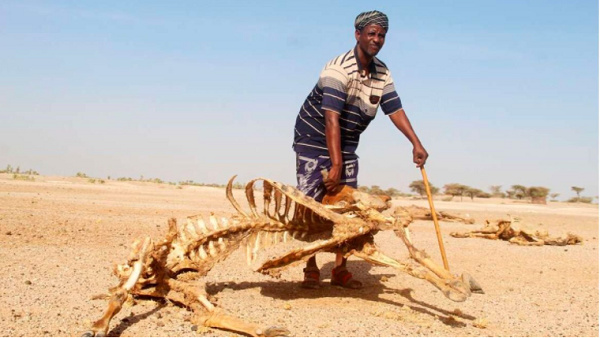  A herder holds a dried-out carcass in Horri Guda, Kenya |
| A herder holds a dried-out carcass in Horri Guda, Kenya |
NAIROBI, March 27 (NNN-AGENCIES) — About 2.8 million Kenyans in 23 counties are urgently in need of relief food, the government has said.
Although officials said no one had died of hunger so far, drought continues to ravage most parts of the country.
Government Spokesperson Cyrus Oguna said this was an increase from the 2.1 million people who were starving last September.
However, a report by Oxfam International released last week showed that the number of people affected could be as high as 3.1 million.
Among the affected counties are Baringo, Isiolo, Mandera, Marsabit, Samburu, Turkana, Wajir, Kilifi, Lamu, Nyeri, West Pokot, Laikipia, and Garissa, which are in the alarming drought stage.
The situation is deteriorating in Makueni, Taita Taveta, and Tana River, while for Embu, Kajiado, and Narok, the situation is stable. Meru and Tharaka Nithi are in the alert stage, while the situation is improving in Kitui and Kwale counties.
A food and nutrition security assessment conducted in January by the National Drought Management Authority (NDMA) found that more than 600,000 children are acutely malnourished.
NDMA attributed the food and nutrition insecurity to several factors, among them the December short rains, high cost of staple food and low livestock prices, the Covid-19 pandemic, and the effects of conflict and insecurity in northern Kenya.
According to the weatherman’s forecast for the long rains season from March to May, the peak of the rain is expected to be in April. Oxfam has warned that more than 28 million people across East Africa will face severe hunger should the rains fail.
“East Africa faces a profoundly alarming hunger crisis. Areas of Ethiopia, Kenya, Somalia, South Sudan, and beyond are experiencing an unfolding full-scale catastrophe. Even if the rains do arrive this month, full recovery will be near impossible unless urgent action is taken today,” said Oxfam Executive Director Gabriela Bucher.
Oguna said the government has spent Ksh1.2 billion on food aid and cash transfers for 380,000 people.
“Next week, we will start phase two of the cash transfer and food aid programme and this will go on until the situation improves,” Oguna said.
This week, he said, the government has distributed relief food even in areas that are yet to be affected, such as Kieni in Nyeri and Nyatike in Migori.
He pointed out that the logistics of transporting relief food would take about two-thirds of the funds set aside for emergencies.
Oguna added that some of the challenges facing the initiative were lack of proper network coverage in some parts of the country and theft of relief food. — NNN-AGENCIES
